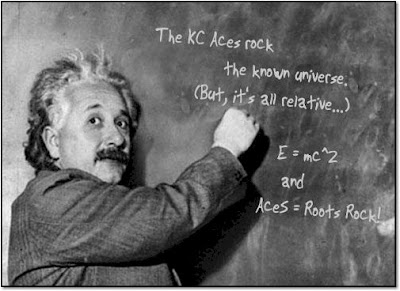Relativity Still Holds Up: 5 Recent Tests That Prove Einstein Right
Time Dilation
The latest test of Einstein's theory of relativity, published in September 2010 in Science, looks specifically at time dilation, a piece of the theory that predicts that two identical clocks resting at different heights or moving at different speeds will tick at different rates. Time dilation is most commonly thought of in terms of the twin paradox: If one twin goes asteroid-hopping on a rocket moving at extremely high speeds, he'll have aged less than his earthbound sibling when he gets home. Now, however, physicist Chin-Wen Chou and his colleagues at the National Institute of Standards and Technology have shown that time dilation can be observed even without a far-flung, fast-moving trip.
Using super-sensitive optical clocks, they measured changes in the clocks' tick rates at speeds of less than 25 miles per hour and at differences in altitude of about a foot. The optical clocks, each powered by a single aluminum ion, are nearly 40 times as accurate as the international-standard cesium-powered atomic clocks, giving researchers the ability to look at minute differences in tick rates. Sitting still at the same height, the clocks had the same tick rate. To move one clock, the researchers simply started one of the ions oscillating at a speed of their choosing. "It can be as slow as you sitting on a swing, swinging back and forth, or as fast as a bullet train," Chou says. When he set the ion moving at 10 meters per second (a little under 25 miles per hour), Chou found that that clock ticked at a measurably slower rate than the stationary clock. The same thing happened when the clocks were at slightly different heights. When Chou and his team used hydraulic jacks to lift one clock just over a foot, the lower clock's tick rate was ever-so-slightly lower than that of the higher clock. Because optical clocks allowed them to measure carefully enough, the researchers could see that Einstein's predictions played out even in everyday circumstances like the height of a footstool and the speed of a car on a residential street.
What about when someone's high up and moving quickly—in a plane, say, moving at 500 miles an hour about six miles off the ground. Which sort of time dilation wins out: the slower tick rate from increased speed, or the faster tick rate from lower gravity? As an example, let's take the feat of George Clooney's character in Up in the Air, who flew 10 million miles on commercial aircraft. Aside from racking up an astonishing number of frequent flier miles, that jetsetter would, Chou figures, have aged 59 microseconds less than his colleagues on Earth.
Spin Precession
Spin precession, a corollary tucked within the greater theory of relativity, predicts that when two objects orbit each other, their masses will distort the central axis they're orbiting around so that it slowly changes direction. This gradual shift causes the two objects to wobble within their orbits.
How It Was Tested
To find the wobble, an international research team studied a pair of pulsars—dense neutron stars that emit radio signals so powerful they can be detected from Earth—that circle each other in close orbits. This pair, the only two pulsars known to orbit each other, was first spotted in 2003, providing an opportunity to test a yet unproven prediction of relativity theory. After tracking the radio signals from one of the stars for four years, the scientists announced in 2008 that, sure enough, it was wobbling, just as Einstein had surmised.
Space-Time Curvature
Sending communications to and from the Viking lander on Mars in 1979, scientists showed that signals traveling between Earth and Mars took slightly longer when they passed the Sun, due to the curvature in space-time caused by the massive star.
How It Was Tested As the spacecraft Cassini was heading towards Saturn in 2002, scientists again measured the effect of solar gravity, looking at how the round-trip time of a radio signal changed when it went near the sun. Although the Cassini test showed the same result as that of the Viking, it was 50 times as accurate—within 20 parts per million, thanks to a better communication system that could filter out interference from the solar corona.
Time Dilation in Lasers
Time dilation over tiny distances was tested not once, but twice in 2010.
How It Was Tested
While cesium atoms no longer power the world's most accurate clocks, they have been used to observe time dilation over the smallest difference in altitude yet: one-tenth of a millimeter, or about four-thousands of an inch. In a study published this February, scientists bombarded cesium atoms with photons from a laser. When a photon hits a given atom, it pushes it into two alternate realities, according to the laws of quantum mechanics. In one of these alternate realities, the atom's path is unchanged; in the other, the atom absorbs the photon, propelling it one-tenth of a millimeter higher. By looking at the difference between the oscillation rate of the higher and lower atom, the researchers could observe time dilation over this tiny distance, with an accuracy of one part in 100 million.
Large-Scale Relativity
As big as a solar system is, it's a small sample when you're out to test a theory about the entire universe. The fact that general relativity hadn't been proven on a larger-than-solar-system scale, however, left some scientists to wonder if the theory would still hold over greater distances.
How It Was Tested
Using far-reaching observations from NASA's powerful Chandra X-ray telescope, researchers were able to provide support for relativity on a cosmological scale. They found that Einstein's theory accurately predicted how galaxy clusters—large groups of galaxies held together by gravity—grew over time.

0 comments:
Post a Comment